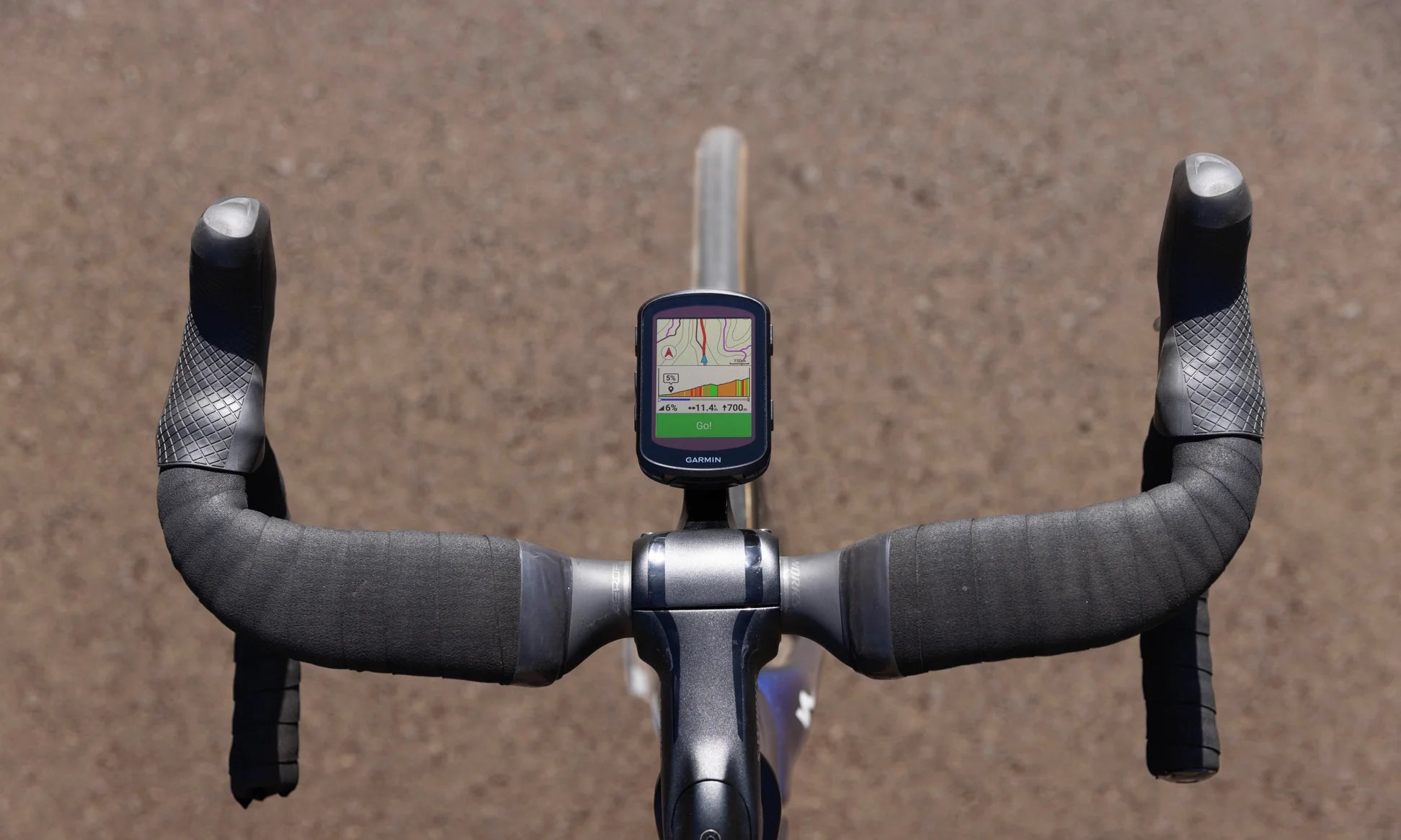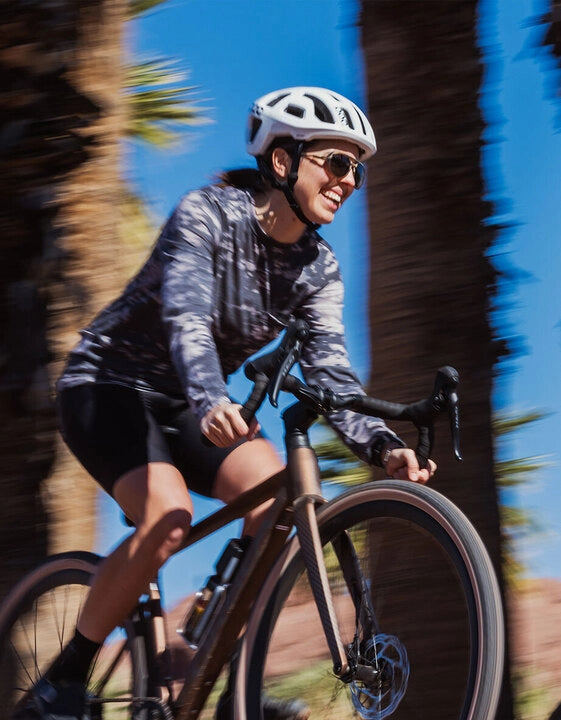A GPS head unit, a.k.a. a cycling computer, is essential to making it to the finish of Unbound Gravel. The course is remote and unmarked, so riders have to rely on a GPS file of the route and turn-by-turn directions to navigate.
Note: Unbound does provide official cue sheets if you want to navigate without GPS, but very few riders use them.
If you’re planning to do any sort of extra-long endurance gravel race, it’s a good time to consider if your current head unit can go the distance. Unbound is unique, because at 200 miles long, some GPS head units can’t make it to the finish on a single charge.
I’ll explain why I chose the Garmin Edge 540 Solar for Unbound, give you a few of my other top cycling computer picks, and suggest a couple more electronics like power meters and headphones that could improve your race experience and help you finish strong.
[button]Shop Cycling Electronics[/button]
Bike Computer Battery Life Comparison
For the 200-mile event, riders can expect to be on course for a maximum of 20 hours. Many riders finish after sunset, which occurs just before 15 hours.
The first time I got into the Unbound Gravel 200 in 2022, I had no idea how long it was going to take me to finish the race. I had never ridden 200 miles in one ride, and I was worried that my head unit might die before I finished, which would mean I wouldn’t be able to follow the course.
I knew several riders who had completed Unbound before, so I asked how they dealt with the issue of battery life. I heard of three common solutions:
1. Bring a portable charger or power bank on your bike
2. Use two head units and switch during the race
3. Ride fast enough so that it’s not a concern
Option number 3 was out of the question, and between option 1 and 2, I preferred option 1. Most modern head units can be charged while in use, so if you stick a portable power bank in something like a top tube bag and run a cable to your head unit, it will likely last the full race distance.
Instead though, I opted for another option:
4. Buy a head unit with longer battery life.
The table below compares the claimed battery life for the most popular cycling head units on the market. Keep in mind that using GPS navigation will reduce battery life. In my experience, using navigation and other features can reduce battery life by a couple hours or more.
|
Hammerhead Karoo 2 |
14 hrs |
|
Wahoo Elemnt Bolt V2 |
15 hrs |
|
Wahoo Elemnt Roam V2 |
17 hrs |
|
Garmin Edge 540 |
26 hrs |
|
Garmin Edge 840 |
26 hrs |
|
Garmin Edge 540 Solar |
32 hrs |
|
Garmin Edge 840 Solar |
32 hrs |
|
Garmin Edge 1040 |
35 hrs |
|
Garmin Edge 1040 Solar |
45 hrs |
[newsletter]
My Pick for Unbound: Garmin Edge 540 Solar

When I got into the Unbound 200 in 2022, I owned a Wahoo Bolt and Hammerhead Karoo 2. Both are excellent bike computers (I’ll even explain why I’d recommend them below), but at my speed, I didn’t expect either to last long enough. At the time, Garmin had just released its flagship Edge 1040 Solar.
The standard Edge 1040 already has an impressive 35 hour battery life, but the solar version uses “Power Glass” around the screen made up of solar cells. On a bright and sunny day it adds 20 minutes of battery life per hour, increasing the 1040 Solar’s battery life to 45 hours. If you live somewhere sunny, you could go a month or two without charging it!
I received a test model, which I used at Unbound in 2022 with great results. The battery life was overkill, but I was really impressed with how long I could go without charging it. Unfortunately, I had to send my 1040 Solar back to Garmin at the end of the year.
When it came time to spend my own money, I decided to go with the Edge 1040 Solar’s little brother — the Edge 540 Solar.
[product-block handle="7463484293312-garmin-edge-540-solar-bike-computer"/]
Last year, Garmin released the updated Edge 540 and 840, and they’ve quickly become our best-selling head units, ever. They cost less than the flagship Edge 1040 and they are physically smaller too, which some riders will prefer. Best of all, they have great battery life and come in solar versions that cost $100 more than the standard version, but extend battery life from 26 hours to 35 hours.
Garmin Edge 840 vs. 540
[product-block handle="7463484391616-garmin-edge-840-solar-bike-computer"/]
The 840 costs $100 more than the 540, and the only big difference between the two is that the 840 has a touchscreen as well as buttons. The 540 only uses buttons. Some riders like the convenience of a touchscreen, plus it makes it a bit easier to navigate the Garmin user interface. I’ve had my 540 for a year and I still press the wrong button from time to time. Still, I like saving $100.
Garmin Edge Solar vs. Non-Solar
One thing I’ll note about the solar vs. non-solar versions is that the screens on the solar versions don’t seem as bright as the non-solar versions. I only notice when I compare them side-by-side, but if you like a brighter screen that’s something worth considering. For me, charging my head unit less is more important.
Most Affordable: Wahoo Elemnt Bolt V2
[product-block handle="wahoo-elemnt-bolt-v2-computer"/]
If you just want an affordable head unit that works well and has all the features any cycling geek needs, I usually point people to the Wahoo Bolt. It’s $280, which isn’t cheap, but if you need something for real navigation it’s the cheapest one that I’d consider. If you care about weight, it’s also the lightest full-feature head unit from the big three brands.
I owned the Bolt V1, which got me through the Unbound 100 back in 2017. Seven years later, it still works, though the battery life isn’t as good anymore. The Bolt V2 adds some updates, the biggest being a color screen and USB-C charging.
If you use this with a portable charger, I’d suggest using the charging cable that comes with the head unit since there have been reports that it doesn’t play nice with third party cables.
Best Screen & UI: Hammerhead Karoo 2

Compared to Garmin and Wahoo, Hammerhead is the new kid in school. But damn, is it cool. I love this thing. I think it has the most responsive touchscreen. If you prefer more tactile buttons, the buttons on the side are also big and easy to use.
I’ve been a fan of Hammerhead ever since I was given an original Karoo to test back when it first came out. I liked it a lot, but it was massive. The Karoo 2 got shrunk down, which made it a lot more appealing, so I bought one.
[product-block handle="7392020267200-hammerhead-karoo-2-gps-cycling-computer"/]
The Karoo runs on an Android OS, so thumbing through it feels a lot like using a smartphone. Compared to Garmin and Wahoo’s offering, the learning curve for customizing it and using all the features is very small. The screen itself looks awesome, with great colors, and cool options for dynamic data fields. I’ve heard some people don’t like the matte screen, especially in direct sunlight, but I ran my screen brightness quite high, which decreased battery life, but made this a non-issue for me.
For me, the Karoo 2 had the easiest navigation experience. I just copy and paste the URL for a GPS route into the Hammerhead dashboard and it shows up on the head unit.
The only major downsides are the shorter battery life and the proprietary mounts. I had 4 bikes with Garmin mounts, so I had to purchase all new mounts. Also, there are plenty of rumors that a Karoo 3 is coming this year so there’s that to consider. It’s very likely the Karoo 2 will go on sale as a result.
Longest Battery Life: Garmin Edge 1040 Solar
[product-block handle="7392025641152-garmin-edge-1040-bike-computer"/]
You can’t beat a 45 hour battery life. During a good month, I average 5-7 hours of riding a week. That means I could go a month or two without charging this thing.
The trade-off for this extreme battery life is cost and size. Whether the cost ($750!) matters is up to you. As for size, you get used to it very quickly. The big screen can be nice. Everything is easier to read and it’s all less claustrophobic. I just can’t afford it. It’s an “if I could, I would,” sort of product.
Do You Need a Power Meter for Unbound?

If I'm riding into the wind, I want a power meter.
As a data geek, I like to run power meters on all of my bikes. A power meter allows riders who are serious about performance to do structured training, track progress, and pace themselves using their power numbers. At Unbound, I plan to do a lot of pacing with the help of my power meter.
Using a Power Meter as Part of My Pacing Plan
Pacing off your perceived exertion is good enough, but I like having a power meter just to keep myself in check. In the heat of the moment, it’s super easy to get excited and overreach. This is what happened to me in 2022. I ignored my power numbers and stuck with some fast riders, which caused me to blow up early, get dropped, and lose a lot of time.
With my power meter, my plan is to use a power window — 150-250 watts — which will keep me within my endurance zone (a.k.a. “Zone 2”), which is well below my threshold (which you can determine using an FTP test). My goal is to ride within that window for the majority of the race.
There will be instances where I’ll need to ramp up the power to join or hang onto a fast group of riders. I will want to do this because working with a group and using the draft helps you go faster. So I’ll set an upper limit for how far I can extend myself. If I have to hold 300-350 watts for more than a few minutes, I’m probably going too hard and it’s a sign that I need to just let that group go.
Having my power numbers in front of me with a simple plan that I can follow just makes these decisions easier, and it keeps my ego from convincing me to hold on longer and digging myself into a hole.
A Cheaper Alternative: Heart Rate Monitors
You can also pace with a heart rate monitor. I didn’t have a power meter when I raced the Unbound 100 in 2017, but I used a similar pacing strategy by keeping my heart rate within a certain window.
I knew my threshold heart rate was around 176 BPM. So if I started going above 170 BPM, I toned things down or let a group go. This strategy got me to 7th place in the 100-mile event that year! The downside is that heart rate isn’t as consistent as power because it can be affected by things like fatigue, stress, sleep, and caffeine. For serious and competitive riders, power is still the gold standard.
Riding Into a Headwind is Nicer with a Power Meter
Another reason I like having a power meter is the wind. Unbound is notorious for wind, and the North course is known for having a lot of headwinds in the back half.
Riding into the wind sucks. You feel like you’re pedaling hard but barely moving, so it can destroy your morale. In those situations, power meters keep me sane. It lets me know I’m doing the right amount of work — i.e., staying in that power window — so I don’t end up going too hard or getting discouraged.
Good Power Meter Options
[product-block handle="6586447036608-garmin-rally-xc100-single-sensing-power-meter-pedals"/]
If you don’t have a power meter on your bike, the easiest solution for a lot of riders is the Garmin Rally XC100 pedals. They’ll work on any bike or drivetrain, they’re accurate, and the battery lasts a really long time.
If you can find a crank arm-based power meter they’re generally cheaper. I use the 4iiii Precision 3 crank-based power meters on my bikes that have Shimano drivetrains.
[product-block handle="quarq-powermeter-spider-107-bcd-for-sram-red-force"/]
My current gravel bike has a SRAM AXS groupset, and in that case I'd just use the SRAM AXS power meter spider designed for AXS cranks. This power meter is made by Quarq, and is a top-notch piece. If you have a direct-mount chainring, it will require a new 107 BCD chainring.
Dual-Sided vs. Single-Sided Power Meters
The dual-sided Garmin Rally XC200 costs $500 more than the single-sided XC100. That is a lot of money! If you are ever shopping for a power meter and have to choose between a cheaper single-sided or a more expensive dual-sided power meter, I think it’s fine to get the single-sided one.
A dual-side power meter measures power from both legs while a single-sided power meter measures the power from your left leg and then doubles it. Every rider has some discrepancy between legs but it generally not worth paying attention to unless it’s relatively serious (i.e., you have an injury or some other serious issue). The most important thing for a power meter is to be consistent and accurate.
My Favorite Morale Boosters: Shokz Headphones
[product-block handle="shokz-open-run-pro-open-ear-headphones"/]
[product-block handle="shokz-open-run-open-ear-headphones"/]
[product-block handle="shokz-openfit-open-ear-headphones"/]
Audiophiles tend to hate bone-conduction headphones. Well, I love them. They allow me to listen to music and podcasts while riding without blocking ANY external noise. They’re safer than other options since they allow me to hear other riders, my bike, and vehicles on the road.
Some riders see riding or racing with music as abhorrent. This race, however, is VERY long and putting on some music helps lift my spirits when I’m suffering. When I start at Unbound, I’ll be wearing these. I won’t turn them on until much later, when I’m riding alone and feeling down.
BTW, You Also Need Lights at Unbound
 I just use the same 500 lumen Niterider light I use for commutes and for a post-work rides.
I just use the same 500 lumen Niterider light I use for commutes and for a post-work rides.
All Unbound competitors are required to have head and taillights in case they have to finish in the dark. The Rider’s Guide says they need to be on your bike, but I just keep them with my support crew so I can throw them on my bike at the second checkpoint if needed. Based on what I’ve seen, that seems to be what most riders do.
[product-block handle="niterider-pro-2200-race-headlight"/]
The Niterider Pro 2200 Race Headlight is what I’d use at a 24-hour MTB race on dark and twisty singletrack. It’s super bright and has an external battery so it can last through the night.
I’m probably just going to bring a basic commuter light to Unbound though. I have a bin full of Niterider and Light and Motion commuter lights to choose from. The terrain isn’t technical enough for me to feel like a super expensive and bright light is necessary. Plus, if all goes to plan, I won’t finish in the dark.
The sun sets around 8:45, so if you’re the last rider to cross the finish line at 2:00 AM, you’ll need your light to last a maximum of 5 hours and 15 minutes. For most people, a standard commuter light on the low setting should last long enough. Still, it might be worth actually testing your light if you think you’ll be out on course that long.
[button]Shop Cycling Electronics[/button]
























